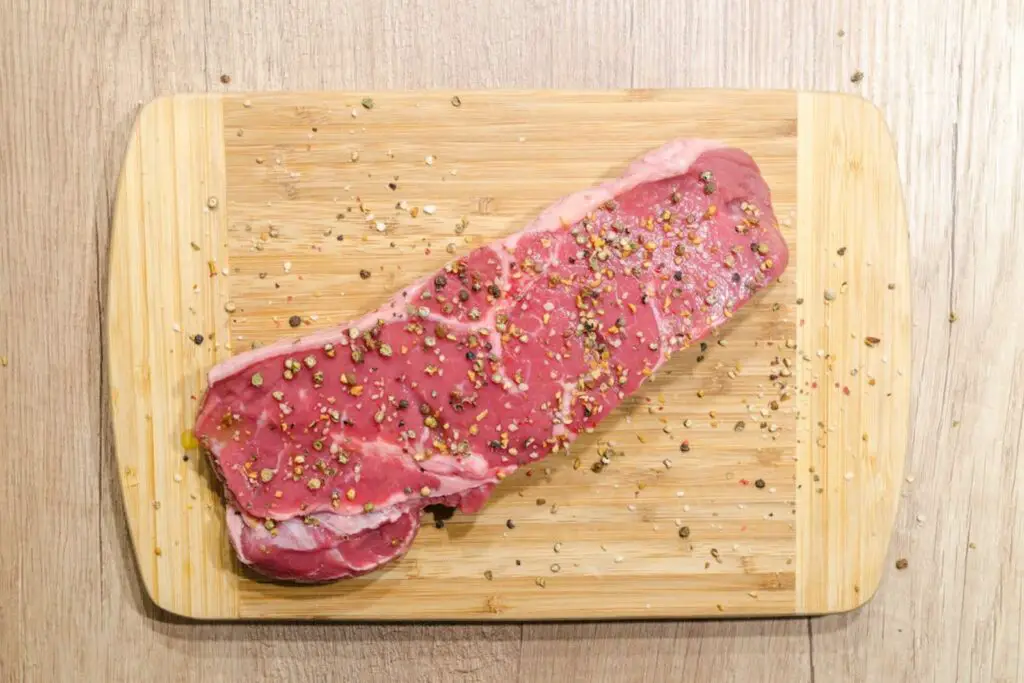
Ham off the bone, with its savory and smoky flavors, is a classic centerpiece for many holiday meals and special occasions. Whether you enjoy it thinly sliced in sandwiches, diced in salads, or served as a main dish, ham off the bone is a versatile and delicious protein option. If you have leftover ham or want to stock up for future meals, freezing is a convenient way to preserve its taste and texture. Freezing ham off the bone allows you to extend its shelf life while ensuring that you can enjoy its succulent flavors whenever you desire. In this guide, we will explore the best practices for freezing ham off the bone, including proper wrapping, storage techniques, and thawing instructions, so you can savor the taste of this beloved meat long after the initial serving. Join us as we uncover the secrets of freezing ham off the bone and embrace the versatility and convenience it brings to your culinary repertoire.
Here are the simple steps to freeze ham off the bone:
Step 1: Select Fresh Ham off the Bone
Selecting fresh ham off the bone is crucial to ensure the best quality and taste after freezing. Here’s why this step is important:
- Quality and taste: Fresh ham off the bone will have a better flavor and texture compared to ham that has been stored for a long time or shows signs of spoilage. Choosing high-quality ham off the bone ensures that it will freeze well and maintain its delicious taste when thawed.
- Safety: Fresh ham off the bone is less likely to harbor harmful bacteria or pathogens. Freezing helps to preserve the ham and extend its shelf life, but it does not kill bacteria. Starting with fresh ham off the bone minimizes the risk of foodborne illnesses.
- Texture: Ham off the bone that is past its prime or has been improperly stored may develop a rubbery or unpleasant texture. Selecting fresh ham off the bone allows you to freeze it at its peak freshness, preserving its desired texture and juiciness.
- Nutritional value: Fresh ham off the bone retains more of its nutritional value, including protein, vitamins, and minerals. By choosing fresh ham off the bone, you ensure that you’re freezing a product that is still rich in nutrients.
To select fresh ham off the bone follow these steps:
- Check the expiration date: If purchasing pre-packaged ham off the bone, verify the expiration or “best by” date to ensure it has not expired.
- Inspect for spoilage: Look for any signs of spoilage such as an off odor, slimy texture, or discoloration. Avoid ham off the bone that shows these signs, as it may indicate bacterial growth or degradation.
- Purchase or freeze promptly: If buying fresh ham off the bone from a butcher or deli counter, try to freeze it as soon as possible after purchase. Similarly, if you have cooked ham off the bone and want to freeze the leftovers, do so promptly to maintain its quality.
By selecting fresh ham off the bone, you set the foundation for a successful freezing process. This step ensures that the ham off the bone retains its flavor, texture, and nutritional value, providing you with a delicious ingredient to use in various recipes even after freezing.
Step 2: Slice or Leave Whole
Deciding whether to freeze the ham off the bone in sliced or whole form is an important consideration based on your preferences and intended use. Here’s why this step offers choices and what each option entails:
Sliced ham off the bone:
- Slicing the ham off the bone before freezing offers convenience, especially if you plan to use it in sandwiches, wraps, or as a topping. Here’s why slicing can be beneficial:
- Portion control: Slicing the ham off the bone allows you to freeze it in individual portions or desired serving sizes. This way, you can thaw only what you need, reducing waste and ensuring that the rest of the ham remains frozen.
- Easy handling: Sliced ham off the bone is easier to handle and separate when frozen. It eliminates the need to thaw the entire piece of ham before using a portion, making it more convenient for quick meals or snacks.
- Ready-to-use: When you freeze the ham off the bone in sliced form, it’s already portioned and ready to incorporate into recipes without additional preparation.
Whole ham off the bone:
- Freezing the ham off the bone in its whole form provides more flexibility in its future use. Consider the following advantages:
- Versatility: Keeping the ham off the bone whole allows you to adapt its use according to your needs. You can slice it later for sandwiches, dice it for soups or salads, or cook it as a centerpiece for a meal.
- Customized portioning: With a whole ham off the bone, you have the freedom to cut it into various sizes depending on your recipe requirements or the number of servings you want to prepare.
- Longer storage time: Keeping the ham off the bone whole and uncut can potentially extend its freezer storage life. By slicing it only when needed, you reduce the exposure to air and moisture, which can contribute to freezer burn or quality deterioration.
To decide between slicing or leaving the ham off the bone whole:
- Consider your intended use: Think about the recipes or dishes you plan to prepare with the ham off the bone. If you primarily need it for sandwiches or quick snacks, slicing might be more convenient. However, if you want flexibility in how you use the ham or prefer to have larger portions, keeping it whole could be a better choice.
- Storage space: Consider the available freezer space you have. Sliced ham off the bone takes up more room due to individual portions, whereas a whole ham off the bone requires less space.
- Personal preference: Your personal preference and cooking style also play a role. Some people enjoy the process of slicing ham off the bone when needed, while others prefer the convenience of pre-sliced portions.
Ultimately, whether you choose to freeze the ham off the bone in sliced or whole form, both options have their advantages. Consider your specific needs and preferences to make the decision that best suits your cooking habits and future usage of the ham off the bone.
Step 3: Wrap and Package
Properly wrapping and packaging the ham off the bone before freezing is essential to maintain its quality, prevent freezer burn, and protect it from air exposure. The specific wrapping method may vary depending on whether you are freezing sliced ham off the bone or the whole ham off the bone. Here’s why this step is important and the recommended techniques for each:
Sliced ham off the bone:
- When freezing sliced ham off the bone, it’s crucial to prevent the slices from sticking together. This ensures that you can easily separate and thaw individual portions as needed. Here’s how to accomplish this:
- Separate with wax paper or parchment paper: Place a sheet of wax paper or parchment paper between each slice of ham off the bone. This creates a barrier that prevents the slices from freezing together.
- Stack and wrap: After separating the slices, stack them neatly and wrap the entire portion tightly in plastic wrap or aluminum foil. This additional layer of protection helps prevent moisture loss, freezer burn, and contamination.
Whole ham off the bone:
- Preserving the quality of a whole ham off the bone requires adequate wrapping to maintain its flavor and texture during freezing. Here’s how to properly wrap a whole ham off the bone:
- Tightly wrap in plastic wrap or aluminum foil: Start by tightly wrapping the whole ham off the bone with plastic wrap or aluminum foil. Ensure that the wrapping is secure and there are no gaps or exposed areas.
- Consider double-layering: For added protection, consider using a second layer of wrapping. This can help further reduce the risk of freezer burn and maintain the ham’s moisture content.
Proper wrapping and packaging techniques create a barrier that helps maintain the quality and prevent the ham off the bone from absorbing odors or flavors from other foods in the freezer. It also safeguards against freezer burn, which can negatively impact the taste and texture of the ham off the bone.
Step 4: Place in a Freezer-Safe Container
After wrapping the ham off the bone, it’s important to transfer it into a suitable freezer-safe container. This step helps protect the ham from freezer burn, maintain its quality, and keep it well-organized within the freezer. Here’s why using a freezer-safe container is recommended:
- Minimize freezer burn: Freezer burn can occur when the ham off the bone is exposed to air and moisture in the freezer. By placing it in a freezer-safe container, you create an additional layer of protection against these elements, reducing the risk of freezer burn and maintaining the ham’s texture and flavor.
- Preserve quality: Airtight containers help maintain the ham’s moisture content and prevent the absorption of unwanted odors from other freezer items. This preserves the quality and taste of the ham off the bone during its storage in the freezer.
- Organization: Using a freezer-safe container keeps the ham off the bone neatly contained and makes it easier to stack and organize within the freezer. It helps maximize storage space and allows for efficient retrieval when needed.
Here are some recommended freezer-safe containers:
- Airtight plastic bags: Choose high-quality, thick, and freezer-specific plastic bags that are designed to withstand low temperatures without tearing or developing leaks. Press out any excess air from the bag before sealing to minimize the risk of freezer burn.
- Freezer-safe containers: Opt for containers specifically labeled as freezer-safe or suitable for freezing. These containers should be airtight and made of materials that can withstand freezing temperatures without cracking or warping.
When selecting a freezer-safe container, ensure it is of an appropriate size to accommodate the wrapped ham off the bone without leaving excessive empty space. This helps prevent the ham from shifting during freezing, which can lead to potential freezer burn.
By placing the wrapped ham off the bone in a freezer-safe container, you provide an additional layer of protection against freezer burn, maintain its quality, and facilitate efficient storage in the freezer. This step ensures that your ham off the bone remains in optimal condition until you’re ready to use it.
Step 5: Label and Date
Labeling and dating the package containing the frozen ham off the bone is an important step to help you keep track of its freshness and ensure that you use it within the recommended storage time. Here’s why this step is crucial and how it benefits you:
- Easy identification: By labeling the container or bag, you can easily identify the contents without having to open or guess what is inside. This is particularly useful if you have multiple items stored in the freezer.
- Freshness tracking: Adding the date of freezing allows you to know how long the ham off the bone has been in the freezer. This information is valuable in ensuring that you use it within the recommended storage time to maintain its quality and taste. Different sources may provide varying storage times, but generally, frozen ham off the bone can be stored for up to 2-3 months.
- FIFO (First In, First Out): Labeling and dating the package enables you to follow the FIFO principle, which means using the oldest frozen ham off the bone first. This practice helps prevent food waste and ensures that you rotate your freezer stock effectively.
How to label and date the package effectively:
- Use a waterproof marker or a freezer-safe label to write the contents (ham off the bone) clearly on the container or bag. Make sure the label is easily visible and won’t smudge or fade in the freezer.
- Add the date of freezing, including the day, month, and year. This way, you have a reference point for when the ham off the bone was frozen.
- Place the label in a prominent spot on the package, ensuring it is legible and won’t get covered or damaged during storage.
By labeling and dating the package containing the frozen ham off the bone, you create a clear record of its contents and freezing date. This information helps you stay organized, track freshness, and ensure that you use the ham within the recommended storage time to enjoy its optimal taste and quality.
Step 6: Freeze Promptly
Freezing the packaged ham off the bone promptly after preparation is crucial to preserve its quality and prevent bacterial growth. This step ensures that the ham off the bone remains safe and maintains its flavor and texture. Here’s why freezing promptly is important and how to achieve optimal freezing conditions:
- Temperature control: Freezing the ham off the bone at the right temperature is essential for food safety and quality preservation. Ensure that your freezer temperature is set to 0°F (-18°C) or below. This temperature inhibits the growth of bacteria and helps maintain the ham’s texture, flavor, and nutritional value.
- Minimize bacterial growth: Freezing halts the growth of bacteria but does not kill them. Promptly placing the packaged ham off the bone in the freezer reduces the time bacteria have to multiply and potentially cause foodborne illnesses. It is particularly important if the ham off the bone was not cooked or processed to kill bacteria prior to freezing.
- Texture and flavor preservation: Quick freezing helps to preserve the texture and flavor of the ham off the bone. It minimizes the formation of large ice crystals that can negatively impact the meat’s cellular structure and result in a loss of juiciness and tenderness.
How to achieve optimal freezing conditions:
- Clear space in the freezer: Ensure there is enough space in your freezer to accommodate the packaged ham off the bone without overcrowding. Adequate air circulation allows for uniform freezing and helps maintain the ham’s quality.
- Place in the coldest part of the freezer: Put the packaged ham off the bone in the coldest area of the freezer, such as the back or bottom shelf, to ensure it freezes quickly and evenly.
- Avoid temperature fluctuations: Minimize opening the freezer door unnecessarily, as it can cause temperature fluctuations that affect the freezing process. Also, avoid placing the ham off the bone near warm or hot items that could raise the surrounding temperature.
By promptly placing the packaged ham off the bone in the freezer at the appropriate temperature, you ensure the optimal preservation of its quality, flavor, and safety. This step is essential for maintaining the ham off the bone’s freshness until you are ready to use it.
How long can ham off the bone last in the freezer?
Ham off the bone can last in the freezer for up to 2-3 months. Properly wrapped and stored at 0°F (-18°C) or below, frozen ham off the bone maintains its quality, flavor, and texture within this timeframe. It’s important to label the package with the freezing date and ensure airtight packaging to prevent freezer burn and maintain optimal freshness.
Step 7: Thaw the Frozen Ham
Thawing the frozen ham off the bone properly and storing it correctly are essential steps to ensure food safety and maintain the quality of the meat. Here’s why these steps are important and how to thaw the ham off the bone effectively:
Thawing process:Thawing the frozen ham off the bone allows it to return to a safe temperature for consumption and prepares it for cooking or serving. Proper thawing helps maintain the ham’s texture, flavor, and overall quality.
Here are two recommended methods for thawing:
- Refrigerator thawing: The safest method for thawing the ham off the bone is to transfer it from the freezer to the refrigerator. Place the packaged ham off the bone on a tray or in a shallow dish to catch any drips. Allow it to thaw slowly in the refrigerator overnight or for about 24 hours per 5 pounds (2.3 kg) of ham. This gradual thawing process helps maintain the ham’s quality and minimizes the risk of bacterial growth.
- Microwave defrosting: If you need to thaw the ham off the bone quickly, you can use the defrost setting on your microwave. Follow the manufacturer’s instructions for defrosting times based on the weight of the ham. Be cautious not to partially cook the ham during the defrosting process, as this can affect its texture and taste.
By properly thawing the ham off the bone and storing it appropriately, you ensure food safety and maintain the meat’s quality. Thawing properly allows you to enjoy the ham off the bone in your recipes or meals while minimizing the risk of foodborne illness and maximizing its taste and texture.
Other related questions
Can you refreeze ham off the bone?
Yes, it is generally safe to refreeze ham off the bone if it has been thawed properly and remains in good condition. However, each refreezing cycle may affect the quality and texture of the ham, leading to potential loss of flavor and moisture. It is recommended to refreeze ham off the bone only once and handle it safely to minimize the risk of bacterial growth and maintain its overall quality.
How do I know if the ham off the bone has gone bad after being frozen?
To determine if frozen ham off the bone has gone bad, there are several signs to look for. These include a noticeable change in color, an off or rancid odor, the presence of mold, or the development of a slimy or sticky texture. Additionally, if the ham off the bone exhibits an unusual or sour taste, it is an indication of spoilage. If any of these signs are present, it is best to discard the ham off the bone to avoid the risk of foodborne illness.
Can I freeze ham off the bone for use in casseroles or quiches?
Yes, you can freeze ham off the bone for use in casseroles or quiches. It is recommended to dice or chop the ham into desired-sized pieces before freezing. Package the ham in airtight freezer bags or containers, removing as much air as possible, and label them with the date. Thaw the frozen ham in the refrigerator and incorporate it into casseroles or quiches according to your desired recipe.
Can I freeze ham off the bone for future slicing or carving?
Yes, you can freeze ham off the bone for future slicing or carving. It is advisable to slice or carve the ham before freezing if you plan to use it for individual servings. Wrap the sliced or carved ham tightly in plastic wrap or place it in airtight freezer bags or containers, removing as much air as possible. Thaw the frozen ham in the refrigerator and use it for sandwiches, charcuterie boards, or other purposes that require sliced or carved ham.
Can I freeze ham off the bone with a honey or maple glaze?
Yes, you can freeze ham off the bone with a honey or maple glaze. However, it is recommended to freeze the ham without the glaze for optimal results. Freezing the glazed ham may alter the texture and quality of the glaze. When ready to use, thaw the frozen ham in the refrigerator, and then reapply the honey or maple glaze before reheating or serving.
Can I freeze ham off the bone for making ham and bean soup later?
Yes, you can freeze ham off the bone for making ham and bean soup later. Start by cutting the ham into desired-sized pieces suitable for the soup. Place the ham in airtight freezer bags or containers, removing as much air as possible. Thaw the frozen ham in the refrigerator before adding it to your ham and bean soup recipe for delicious and flavorful results.








